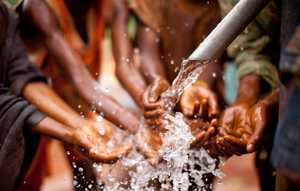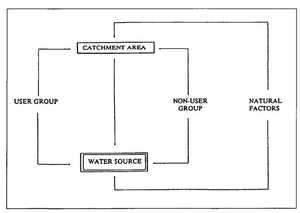
Drinking-water source deterioration
Drinking-water source deterioration: an urgent problem by Teun F. Bastemeyer and Michael D. Lee. The effective management and protection of water sources is vital, especially as the threat of pollution increases.
THE DEVELOPMENT of an adequate and sustainable drinking-water supply depends on the existence of a reliable water source; one that can provide a yield of sufficient quality and quantity throughout the life of the supply system. Increasing demand and pollution can follow the development of a water supply system as populations grow and water use expands and diversifies. Failure to protect a source from the impacts of polluters and depletory such as agriculture, industry, and upstream communities, exacerbates local pressures and leads to a rapid deterioration in the quality, quantity and reliability of the drinking-water supply. The effective management and protection of water resources is vital, and this is nowhere more true than for the sources relied upon by small and medium-sized communities in the developing world who have few technical, economic, or legal means to protect them against water source deterioration.
The 1987 Report of the World Commission on Environment and Development stressed that many efforts at environmental management had so far been inappropriate, and recommended that in dealing with environmental issues, we must shift our attention from the effects to the causes'. Such awareness that measures must be taken to prevent the causes of the deterioration of drinking-water resources is increasing. Environmental protection and management is now an equal priority with the three other factors essential to achieve sustainable development: technical soundness and suitability; community participation and management; and economic affordability and viability. In fact, several international awareness-raising initiatives have taken place in 1992:
- A meeting in January of government representatives at the International Conference on Water and the Environment in Dublin resulted in a statement calling for fundamentally new approaches to the development and management of freshwater resources, approaches which require political commitment and involvement at all levels.
- In February, the Second International Water Tribunal convened in Amsterdam to focus world attention on cases of deteriorating water resources in developing countries caused or exacerbated by the activities of national governments, international lenders, or multinational corporations.
- The United Nations Conference on Environment and Development was convened in Rio de Janeiro to establish a basis for the formulation of systematic national and regional policies for sustainable development. It was attended by heads of state and will form the basis for national and international integrated water resource development and management, water resource assessment, and resource protection.
These initiatives are laudable but overdue. During the Water Decade one billion additional people in developing countries were served with an improved drinking-water supply system, bringing the global coverage to 88 per cent for urban areas and 61 per cent for rural areas. Because of population growth, and the failure of many projects to sustain improvements through technical failure, inadequate community management, or environmental deterioration, it is estimated that the number of people still in need of reliable, improved supplies in 1990 was greater than in 1980 when the decade began. Even with the unprecedented progress of the Water Decade, over 1.2 billion people remain un-served around the world.
In most developing countries, overall water use continues to grow faster than the population. In turn, populations are growing at a faster rate than new drinking-water supply systems and sanitation facilities can be developed. Absolute shortages in water supply are occurring both within regions and on a national scale. The number of regions and countries that will experience the effects of growth-related pressures on their water resources will increase in the coming years. Pressures include:
- an increasing demand on finite supplies;
- a reduction in supply because of land-use changes;
- competing uses, from agriculture and industry; and
- increased contamination from untreated human, industrial, and agricultural waste.
Such pressures affect small and large sources alike, both directly and indirectly, and their impacts can only increase in severity. Statistics indicate that agriculture now accounts for around 80 per cent of all water use, (WHO, 1990) and that the total area under irrigation tripled between 1951 and 1980. This trend will continue. Industrial use accounts for around 10 per cent of total water use worldwide (and can be expected to expand significantly in the developing world), and at the same time it accounts for around 80 per cent of all pollution. Domestic consumption accounts for less than 10 per cent of the total withdrawal of water, and it is increasingly pressured by these competing uses.
The relative importance of environmental problems and their tendency to limit drinking-water supply system sustainability can be expected to dramatically increase in the 1990s, even in those developing countries where such problems are not yet considered serious. Foreseeing this problem, the IRC International Water and Sanitation Centre expanded its information base to include water source deterioration issues in relation to community water supply and sanitation. Supported by the Dutch Ministry of Environment, these issues were identified primarily by concentrating on the environmental factors affecting and affected by drinking water supply and sanitation developments under a range of conditions. The variety, size, and scope of source problems testified to a definite need to address the underlying causes more systematically. The findings of IRC's review (IRC, 1991) have encouraged the organization to direct greater attention towards the assessment and control of environmental factors. Previously IRC had concentrated on technical solutions to water scarcity and on enhancing the role of user communities in managing their own development.
Water source problems
Most of us are familiar with the water quality and quantity problems plaguing the industrialized nations. The pollution of the Rhine by a long list of heavy metals and other toxins, for example, has been well publicized. Similarly, the water shortages affecting the State of California during seven consecutive years of drought have made global news, with household water supplies limited by widespread, mandatory, rationing to as little as 50 per cent of normal use. We are far less familiar with the broad array of environmental problems affecting developing country water resources. If we search deep enough into field reports, however, we can see many well-documented examples that show the urgent, critical, need for the protection and improved management of the sources on which millions rely for their drinking-water supplies.
In India, groundwater exploitation for sugar production in Maharashtra State caused village wells to dry up and aquifers to turn saline, increasing the number of villages without a permanent drinking-water source from 1800 to 28 000 between 1985 and 1987. In Gujarat State in the 1980s, mechanized irrigation pumps lowered groundwater levels by 20m, well below the reach of village handpumps; this left an estimated 12 000 wells and 280.000 people without water. In Baluchistan, Pakistan, catchment overgrazing combined with groundwater extraction for irrigation has resulted in the depletion of local aquifers and the lowering of groundwater levels by 26cm per year since the 1960s. In Latin America, serious levels of toxic industrial pollutants have been discovered in rivers, including the Reconquista and Matanza rivers in Argentina, the Choqueyapu-Reni rivers in Bolivia, the Tiete river in Brazil, and the Magdalena river in Colombia, which are used by many small riverside communities for drinking-water. These are but a few of the many instances of deteriorating water supplies that have resulted from the increasing exploitation of our land and water resources.
A few definitons are useful to provide a framework for assessing the nature and causes of water-source deterioration. A reliable water source is one that can meet the present and future needs of the population it serves, both in quality and quantity. Similarly, a reliable supply system is one that consistently delivers the required service level from this resource to the designated community as specified by its design criteria and planned lifespan. A water source problem exists when the quality and quantity of water supply from a given source decreases to the extent that a user community does not receive the specified service level. Clearly, the absolute and relative magnitude of a given problem depends on the differences between the original or design service level and the worsened service. Deteriorating conditions can result from fundamental problems affecting the source itself, or problems that affect the way the supply system and the source combine. An example of the former is where catchment deforestation results in river runoff rather than slow percolation, and so year-round mountain springs disappear and local mountain communities no longer have a source of water. An example of the latter is where the rivers which are fed by the mountain runoff experience greatly increased peak winter flows and a lower summer base-flow. River water intakes on the banks suffer winter flood damage which interrupts supplies to downstream communities, and in the summer yields fall or are reduced to zero as river flow falls below the intake.
Many environmental problems will have been damaging water sources for a considerable time before the user communities recognize the problem. The effects of these impacts will be both difficult and costly to reverse. The gradual contamination of groundwater by nitrates or petro-chemicals is a prime example: serious levels of pollution will have been building up over a long period before the effects are noticed. The symptoms of the depletion problems that will impact yields and reliability are also often hard to identify until a key threshold is passed. Many water supply systems are designed to exploit only a fraction of the available water source, and are built to satisfy water demand that is expected to triple or quadruple over the system's design lifespan. Problems will only become apparent when the system fails to supply the projected needs of a given population much earlier than expected. By then, the causal factors may be deeply entrenched and difficult to remedy. This is a major drawback of adopting a curative approach designed to identify and then mitigate environmental effects through remedial actions. Instead, a preventive strategy is needed, one which builds water source protection into every project or regional water source development plan. This requires a sound understanding of the relationship between the causes of environmental problems, the water sources, the water supply systems, and the communities that use and manage them. It requires an environmental assessment which looks at both the impact a particular water use may have on the water source (and in turn on the sustainability of a supply system), and at the impact that external, usually upstream factors, both natural and developed, may have on the resource and the project.
Systematic framework
Any assessment of environmental impacts will require a systematic analysis of both the local and regional situation. IRC concluded that to identify the causes of source problems, future research and project planning efforts should concentrate on the interrelationships or linkages between water sources, their catchment area, the activities of the user communities and other non-user communities, and any external natural factors. The diagram in Figure I shows the direct (to the source itself) and indirect (through catchment changes) links between the various actors and the water source.

Catchment area: the landscape surface from which the water that is now flowing in the source has collected during rainstorms, and over or through which it has passed to reach the point of use. Changes in the character of the catchment area can affect the quality, quantity, or timing of water flows into the source.
Water user groups: the community that receives its drinking water from the supply system. There may be multiple user groups located upstream and downstream from the others. Each group can influence the quality, quantity, and reliability of the water source for itself and for those downstream.
Non-user groups: individuals located upstream of the user community who do not use the source for drinking-water, but whose activities can significantly affect the character of the water source. Examples could include a logging or mining operation that directly pollutes the source, or a mountain community that practices slash-and-burn deforestation of the catchment for agriculture.
Natural factors: environmental impacts can result from natural events such as earthquakes, fifty-year rainstorms, or climatic changes such as global warming. Since these are generally beyond local, regional, and national controls, they are not considered further in this framework.
For the purpose of illustration, it was useful to break down a review of these linkages by size of water source. Small water sources are generally used by smaller communities and are affected most closely by the community themselves. Large water sources usually support a mix of large and small communities at different locations, and their problems have a range of direct and indirect causes.





